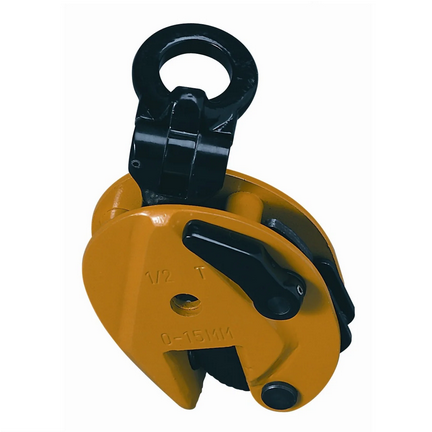Introduction
Plate clamps are indispensable tools in various industries, offering a reliable solution for lifting and moving heavy plates safely and efficiently. Whether in construction, manufacturing, or maritime operations, understanding the ins and outs of plate clamp is crucial for maximizing their utility and ensuring safety. In this comprehensive handbook, we delve into the nuances of plate clamps, providing insights, tips, and best practices to optimize their usage.
Understanding Plate Clamps
Plate clamps, also known as plate lifting clamps or steel plate clamps, are mechanical devices designed to grip and lift heavy plates securely. They come in various types, including vertical, horizontal, and universal clamps, each tailored to specific lifting applications. Vertical clamps are suitable for lifting plates in a vertical position, while horizontal clamps excel at horizontal plate lifting. Universal clamps offer versatility, capable of lifting plates in both orientations.
Types of Plate Clamps
- Vertical Plate Clamps: Vertical plate clamps are designed to lift plates in a vertical position, gripping the edges of the plate securely. They typically feature a locking mechanism that ensures the clamp remains engaged during lifting operations. Vertical clamps come in different configurations to accommodate various plate thicknesses and weights.
- Horizontal Plate Clamps: Horizontal plate clamps are specialized for lifting plates in a horizontal orientation. These clamps often feature a scissor-like mechanism that clamps onto the plate's surface, providing a secure grip for lifting and transporting horizontally positioned plates.
- Universal Plate Clamps: Universal plate clamps offer versatility, allowing operators to lift plates in both vertical and horizontal orientations. They incorporate adjustable mechanisms that accommodate different plate sizes and orientations, making them ideal for diverse lifting requirements.
Key Features and Components
Plate clamps typically consist of several key components, each playing a crucial role in their operation:
- Jaws: The jaws of the clamp are responsible for gripping the plate securely. They often feature serrated surfaces or specialized gripping mechanisms to enhance grip and prevent slippage during lifting.
- Locking Mechanism: Many plate clamps incorporate a locking mechanism to ensure the clamp remains engaged during lifting operations. This mechanism prevents accidental release and enhances safety during lifting.
- Swivel Mechanism: Some plate clamps include a swivel mechanism that allows for easy positioning of the clamp, enhancing maneuverability and flexibility during lifting.
- Load Capacity: Plate clamps are rated for specific load capacities, indicating the maximum weight they can safely lift. It is essential to select a clamp with an appropriate load capacity for the intended lifting task to prevent overloading and ensure safety.
Safety Considerations
Safety is paramount when working with plate clamps to prevent accidents and injuries. Here are some essential safety considerations to keep in mind:
- Inspect Equipment: Before each use, inspect the plate clamp for any signs of damage or wear. Ensure all components are in good condition and functioning correctly.
- Verify Load Capacity: Always check the load capacity of the plate clamp to ensure it is suitable for the weight of the load being lifted. Using a clamp with insufficient capacity can lead to overloading and potential accidents.
- Proper Attachment: Ensure the plate clamp is securely attached to the plate before lifting. Verify that the jaws are properly engaged and that the locking mechanism is activated.
- Avoid Overloading: Never exceed the rated load capacity of the plate clamp. Overloading can lead to equipment failure and pose significant safety risks.
- Secure Lifting Points: Identify suitable lifting points on the plate to prevent slippage during lifting. Avoid lifting from weak or unsupported areas that could cause the plate to deform or fail.
- Use Proper Lifting Techniques: Train operators on proper lifting techniques, including the use of appropriate rigging equipment and lifting procedures. Avoid sudden movements or jerks during lifting operations.
Tips and Best Practices
- Select the Right Clamp: Choose the appropriate type of plate clamp based on the lifting application, plate orientation, and weight. Consider factors such as load capacity, jaw opening width, and plate thickness compatibility.
- Positioning: Proper positioning of the plate clamp is crucial for safe and efficient lifting. Ensure the clamp is aligned correctly with the plate and positioned securely before lifting.
- Maintain Proper Balance: Distribute the load evenly across multiple clamps if lifting large or heavy plates. Maintaining proper balance helps prevent tilting or uneven loading during lifting operations.
- Regular Maintenance: Perform regular maintenance on plate clamps to ensure optimal performance and safety. Clean and lubricate moving parts, inspect for wear or damage, and replace worn components as needed.
- Training and Certification: Provide comprehensive training for operators responsible for using plate clamps. Ensure they are familiar with proper usage, safety protocols, and emergency procedures. Certification programs can help validate operator competency.
- Communicate Effectively: Establish clear communication protocols between operators and other personnel involved in lifting operations. Use hand signals or radios to coordinate movements and ensure everyone is aware of their roles and responsibilities.
Conclusion
Plate clamps are indispensable tools for lifting and moving heavy plates in various industries. Understanding the different types of clamps, key features, and safety considerations is essential for maximizing their utility and ensuring safe operations. By following best practices, conducting regular maintenance, and providing adequate training, operators can harness the full potential of plate clamps while mitigating risks and ensuring workplace safety.





Comments